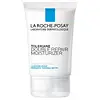What's inside
What's inside
 Key Ingredients
Key Ingredients

 Benefits
Benefits

 Concerns
Concerns

 Ingredients Side-by-side
Ingredients Side-by-side

Water
Skin ConditioningGlycerin
HumectantSqualane
EmollientDimethicone
EmollientZea Mays Starch
AbsorbentNiacinamide
SmoothingAmmonium Polyacryloyldimethyl Taurate
Emulsion StabilisingMyristyl Myristate
EmollientStearic Acid
CleansingCeramide NP
Skin ConditioningPotassium Cetyl Phosphate
EmulsifyingGlyceryl Stearate Se
EmulsifyingSodium Hydroxide
BufferingMyristic Acid
CleansingPalmitic Acid
EmollientCapryloyl Glycine
CleansingCaprylyl Glycol
EmollientXanthan Gum
EmulsifyingWater, Glycerin, Squalane, Dimethicone, Zea Mays Starch, Niacinamide, Ammonium Polyacryloyldimethyl Taurate, Myristyl Myristate, Stearic Acid, Ceramide NP, Potassium Cetyl Phosphate, Glyceryl Stearate Se, Sodium Hydroxide, Myristic Acid, Palmitic Acid, Capryloyl Glycine, Caprylyl Glycol, Xanthan Gum
Centella Asiatica Extract
CleansingHoney Extract
HumectantGlycerin
HumectantWater
Skin ConditioningButylene Glycol
HumectantCaprylic/Capric Triglyceride
MaskingGlyceryl Glucoside
HumectantCyclopentasiloxane
EmollientHouttuynia Cordata Extract
Skin ConditioningMelaleuca Alternifolia Leaf Extract
PerfumingOenothera Biennis Oil
EmollientHelianthus Annuus Seed Oil
EmollientSimmondsia Chinensis Seed Oil
EmollientCamellia Sinensis Leaf Extract
AntimicrobialCyclohexasiloxane
EmollientAcrylates/C10-30 Alkyl Acrylate Crosspolymer
Emulsion StabilisingTromethamine
BufferingLavandula Angustifolia Flower Extract
CleansingChamomilla Recutita Flower/Leaf Extract
AntimicrobialBorago Officinalis Extract
EmollientCentaurea Cyanus Flower Extract
AstringentSalvia Sclarea Extract
AntiseborrhoeicHyacinthus Orientalis Extract
Skin ConditioningPanthenol
Skin ConditioningPolysorbate 80
EmulsifyingBetaine
HumectantSodium Hyaluronate
HumectantHydroxyethyl Acrylate/Sodium Acryloyldimethyl Taurate Copolymer
Emulsion StabilisingPentylene Glycol
Skin ConditioningCaprylyl Glycol
EmollientAllantoin
Skin ConditioningTocopheryl Acetate
AntioxidantMalt Extract
Skin ProtectingBenzyl Glycol
SolventLonicera Japonica Flower Extract
Skin ConditioningPrunus Mume Fruit Extract
HumectantAdipic Acid
BufferingScutellaria Baicalensis Root Extract
AstringentParfum
MaskingEthylhexylglycerin
Skin Conditioning1,2-Hexanediol
Skin ConditioningGlucose
HumectantDisodium EDTA
Propylene Glycol
HumectantSorbitan Isostearate
EmulsifyingChlorophyllin-Copper Complex
AntioxidantPolysorbate 60
EmulsifyingCitric Acid
BufferingCentella Asiatica Extract, Honey Extract, Glycerin, Water, Butylene Glycol, Caprylic/Capric Triglyceride, Glyceryl Glucoside, Cyclopentasiloxane, Houttuynia Cordata Extract, Melaleuca Alternifolia Leaf Extract, Oenothera Biennis Oil, Helianthus Annuus Seed Oil, Simmondsia Chinensis Seed Oil, Camellia Sinensis Leaf Extract, Cyclohexasiloxane, Acrylates/C10-30 Alkyl Acrylate Crosspolymer, Tromethamine, Lavandula Angustifolia Flower Extract, Chamomilla Recutita Flower/Leaf Extract, Borago Officinalis Extract, Centaurea Cyanus Flower Extract, Salvia Sclarea Extract, Hyacinthus Orientalis Extract, Panthenol, Polysorbate 80, Betaine, Sodium Hyaluronate, Hydroxyethyl Acrylate/Sodium Acryloyldimethyl Taurate Copolymer, Pentylene Glycol, Caprylyl Glycol, Allantoin, Tocopheryl Acetate, Malt Extract, Benzyl Glycol, Lonicera Japonica Flower Extract, Prunus Mume Fruit Extract, Adipic Acid, Scutellaria Baicalensis Root Extract, Parfum, Ethylhexylglycerin, 1,2-Hexanediol, Glucose, Disodium EDTA, Propylene Glycol, Sorbitan Isostearate, Chlorophyllin-Copper Complex, Polysorbate 60, Citric Acid
 Reviews
Reviews

Ingredients Explained
These ingredients are found in both products.
Ingredients higher up in an ingredient list are typically present in a larger amount.
Caprylyl Glycol is a humectant and emollient, meaning it attracts and preserves moisture.
It is a common ingredient in many products, especially those designed to hydrate skin. The primary benefits are retaining moisture, skin softening, and promoting a healthy skin barrier.
Though Caprylyl Glycol is an alcohol derived from fatty acids, it is not the kind that can dry out skin.
This ingredient is also used as a preservative to extend the life of products. It has slight antimicrobial properties.
Learn more about Caprylyl GlycolGlycerin is already naturally found in your skin. It helps moisturize and protect your skin.
A study from 2016 found glycerin to be more effective as a humectant than AHAs and hyaluronic acid.
As a humectant, it helps the skin stay hydrated by pulling moisture to your skin. The low molecular weight of glycerin allows it to pull moisture into the deeper layers of your skin.
Hydrated skin improves your skin barrier; Your skin barrier helps protect against irritants and bacteria.
Glycerin has also been found to have antimicrobial and antiviral properties. Due to these properties, glycerin is often used in wound and burn treatments.
In cosmetics, glycerin is usually derived from plants such as soybean or palm. However, it can also be sourced from animals, such as tallow or animal fat.
This ingredient is organic, colorless, odorless, and non-toxic.
Glycerin is the name for this ingredient in American English. British English uses Glycerol/Glycerine.
Learn more about GlycerinWater. It's the most common cosmetic ingredient of all. You'll usually see it at the top of ingredient lists, meaning that it makes up the largest part of the product.
So why is it so popular? Water most often acts as a solvent - this means that it helps dissolve other ingredients into the formulation.
You'll also recognize water as that liquid we all need to stay alive. If you see this, drink a glass of water. Stay hydrated!
Learn more about Water